The
bottom line, it never hurts to work on business
basics. That means either building or reinforcing a foundation
for the inevitable recovery that
will
be taking place.
Yes,
it is difficult to think about positive business results
when so many challenging events are occurring
around the world. But these problems will pass, and
the astute
business
person
that plans ahead will be ready to profit
from the
coming turn-around.
For
help with intercultural education, training and development
within your organization, please consider the worldwide
services of The
Sigma Two Group, international
business management consultants and trainers.
the
International Business Center Staff
IBC
FOCUS ARTICLE: How do Hofstede's Dimensions correlate
with the World's Religions?
by
Stephen J. Taylor, Senior Partner in The
Sigma Two Group and Director of
the International Business Center
 As
the war proceeds in Iraq, there’s increasing
discord throughout the Middle East, dissention in Europe,
and potential
conflict with North Korea in the Far East. Do these worldwide
conflicts have anything in common? As
the war proceeds in Iraq, there’s increasing
discord throughout the Middle East, dissention in Europe,
and potential
conflict with North Korea in the Far East. Do these worldwide
conflicts have anything in common?
This was a question recently proposed by several readers
of the International Business Center Newsletter.
We will
respond to that question through the application of Geert
Hofstede’s research, along with the analysis
of countries’ religious backgrounds, to determine if
there is a correlation between religion and culture – and
ultimately the attitudes, beliefs, and behaviors of people
in the world.
An
interesting recent observation is how various countries
are responding
to current world situations. Some Middle
East leaders have called to their Muslim followers to thwart
the infidels and Crusaders. This is a reference to the conflicts
between the European Christian ‘Crusaders’, the
Muslims, and the Jews that occurred in the Middle East during
the 11th Century AD – over a thousand years ago! Yet
other countries that fought each other just over fifty years
ago (i.e. Japan, Germany, and the USA) are cooperative allies.
What
are the cultural and religious factors that have created
these two significantly different responses?
Over
the history of civilization, millions of people have lost
their lives under the auspices and banner of ‘religion’.
Could these conflicts be based more on the cultural dynamics,
or personalities of people, rather than their religious teachings
or philosophies? In other words, are groups of people – cultural
societies – more under the influence of their cultural
heritage than by religion? Or, have the two merged indiscernibly?
In order
to understand the centuries old discord between the World’s
religions, we decided to explore the differences not based
on dogma, but rather on the social-psychology of
each religion to see how, or if, they correlate with the
cultural dimensions researched and developed by Geert Hofstede.
The religions included in this study are Atheism, Buddhism,
Catholicism, Christianity, Hindu, Jewish, and Muslim.
Recall briefly that Hofstede uses four primary dimensions
to delineate a cultural grouping. They are Power Distance
(PDI) the level of equality, or inequality, between people
within society. Individualism (IDV) the degree the society
reinforces individual or collective achievement and interpersonal
relationships. Masculinity (MAS) the degree the society
reinforces, or does not reinforce, the traditional masculine
work role model of male achievement, control, and power;
and Uncertainty Avoidance (UAI) or the level of tolerance
for uncertainty and ambiguity within the society - i.e.
unstructured situations. (Click here for more detail on
Hofstede’s Cultural Dimensions)
Our methodology
for this study was to identify the predominant religion
(practiced by greater than 50% of the Country’s
population) in each of the countries used in Geert Hofstede’s
study. This data was obtained from the World Factbook 2002,
and was compiled in Table 1 with the Hofstede dimensions
for each country.
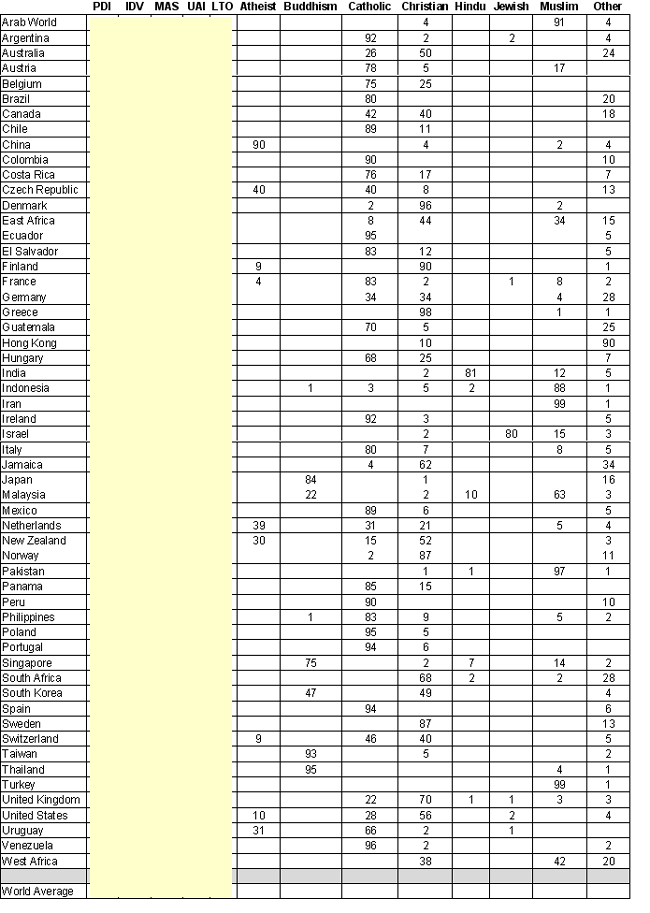
TABLE
1
To view the Hofstede scores for each
country visit:
http://geert-hofstede.com/countries.html
The
Table 1 data was integrated to create a logarithmic graph
for
each religion, and then analyzed for any correlation
between that predominant religion and one or more of Hofstede’s
Dimensions within the grouping. The final results are displayed
in Graphs 1-7.
The result
was a relatively close correlation between each of the
World’s religions and one, or in some cases
two, Hofstede Dimensions. Therefore, the hypothesis of this
study is that a culture, society, or country is inextricably
linked with its religious foundation, and these socio-religious
links make change in any society very difficult. And, due
to the subjective and esoteric nature of religion, it is
not possible to make change based on logic or objectivity.
Here
is a review of each of the World’s religions
and the correlation results:
- Atheist – China’s
religion is officially designated as Atheist by the government.
Some religious practice is
acceptable in China; however, the government sets limits.
Of the five Dimensions (includes LTO) for China, the closest
correlation is with Hofstede’s Power Distance (PDI).
(See Graph below)
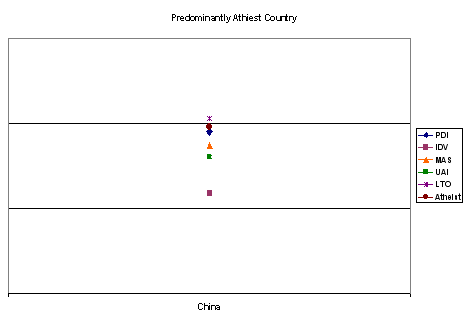

The high Power Distance ranking of an Atheist society
indicates a high degree of inequality between people in
the country's population. This high Power Distance ranking
reflects that an unequal balance of power and wealth have
been allowed to grow within the society.
This means a greater likelihood the country follows a
caste system that limits significant upward mobility of
its citizens. Any culture with a large Power Distance suggests
inherent inequality within the population, and the potential
for exploitation.
- Buddhist – Due
to the close approximation of Buddhist and Shinto societies,
these have been combined for this
study. These countries have the closest correlation with
Hofstede’s Uncertainty Avoidance Index (UAI), which
is the same with Catholic countries. (See Graph below)
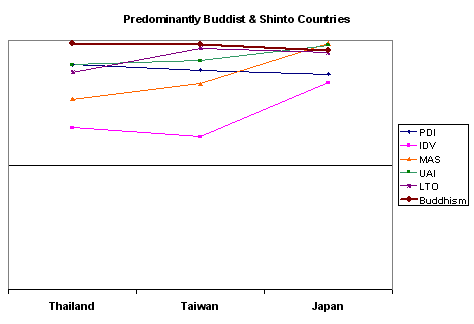
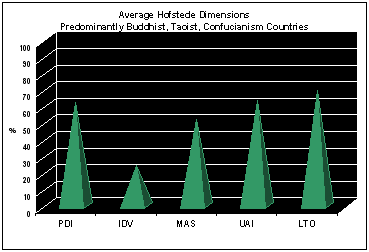
They also have an additional Dimension, that of Long Term
Orientation (LTO). Geert Hofstede added this Dimension
after the original study, and it has been applied to twenty-three
of the fifty original countries in the study.
The
Buddhist/Shinto Countries of Taiwan and Japan have LTO
as the most closely correlating Dimension.
- Catholic – In
the countries that have over 50% of their populations
practicing the Catholic religion we found
the primary correlating Dimension to be Uncertainty Avoidance
(UAI). There were two countries out of twenty-three that
did diverge from this correlation, Ireland and the Philippines.
(See Graph below)
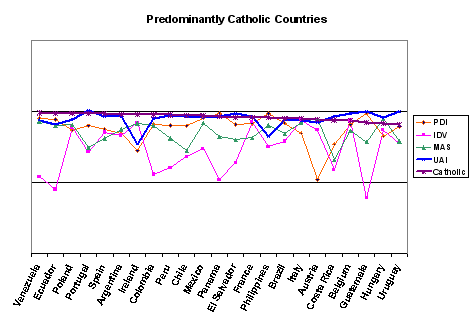
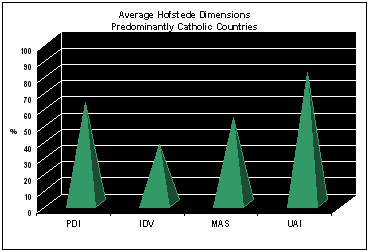
Recalling the characteristics of countries with high UAI
scores, they have a low tolerance for ambiguity. This creates
a highly rule-oriented society that institutes laws, rules,
regulations, and controls in order to reduce the amount
of uncertainty within the population.
- Christian – For
this study, the definition for a Christian country indicates
it has a population of over
50% that practice some form of Christianity, other than
Catholicism. In this group, the primary correlation was
a high Individuality (IDV) score from the Hofstede study.
(See Graph below)
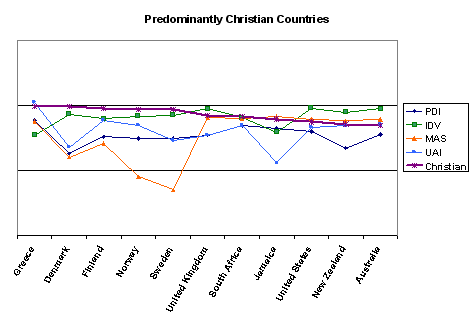
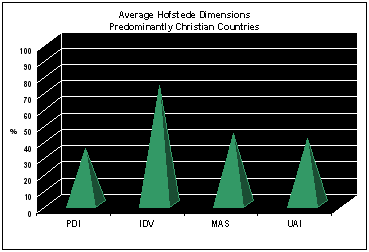
This
indicates that predominantly Christian countries have
a strong belief in individuality, with individual’s
rights being paramount within the society. Individuals
in these countries may tend to form a larger number of
looser relationships.
- Hindu -
There is only one country with over 50% of its population
practicing the Hindu religion – India.
The Hofstede Dimension that correlates most with the Hindu
religion is Power Distance (PDI), the same as the Atheists
in China and the Muslims. (See Graph below) All three have
a high level of Power Distance as the highest correlating
cultural
Dimension
with religions.
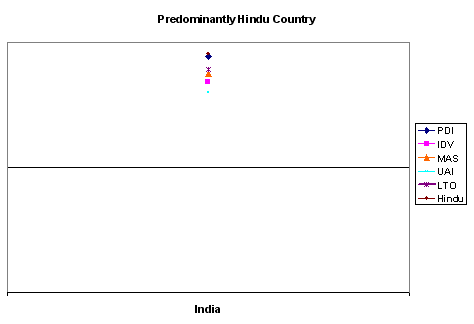
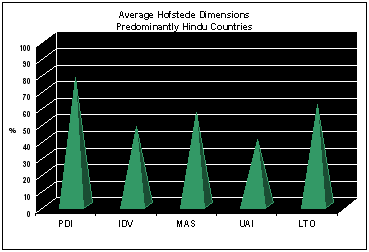
- Jewish -
The Country of Israel’s closest correlating
Hofstede Dimension is Uncertainty Avoidance (UAI), approximating
the results for both Catholic and Buddhist/Shinto countries.
(See Graph below)

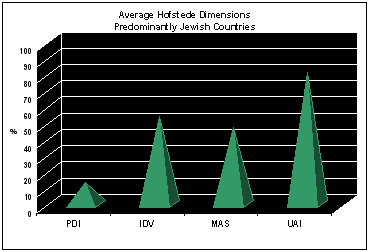
- Muslim – Again,
we have identified a country as being predominantly Muslim
if over 50% of its population
are practicing Muslims. For this group, the Hofstede Dimensions
for the ‘Arab World’ were utilized with a high
correlation between the Muslim religion and the Hofstede
Dimensions of Power Distance (PDI) and Uncertainty Avoidance
(UAI) scores. (See Graph below)
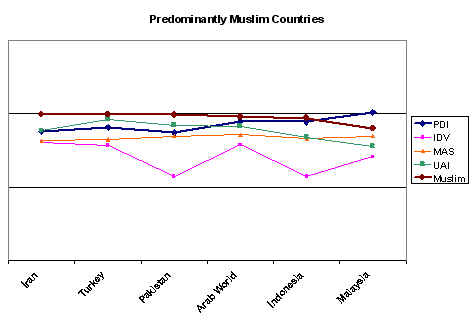
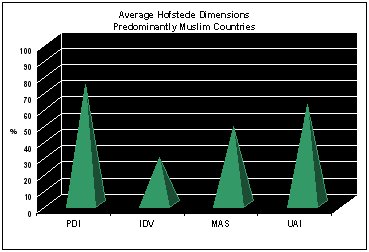
The combination of these two high scores (UAI) and (PDI)
create societies that are highly rule-oriented with laws,
rules, regulations, and controls in order to reduce the
amount of uncertainty, while inequalities of power and
wealth have been allowed to grow within the society. These
societies are more likely to follow a caste system that
does not allow significant upward mobility of its citizens.
When
these two Dimensions are combined, it creates a situation
where leaders have virtually ultimate power and authority,
and the rules, laws and regulations developed by those
in power, reinforce their own leadership and control. It
is not unusual for new leadership to arise from armed insurrection – the
ultimate power, rather than from diplomatic or democratic
change.
Here is a summary of the results:
Atheist = Power Distance
Hindu = Power Distance
Muslim = Power Distance
Buddhist = Uncertainty Avoidance
Catholic = Uncertainty Avoidance
Jewish = Uncertainty Avoidance
Christian = Individualism
Note: No religion correlates with the Masculinity Dimension.
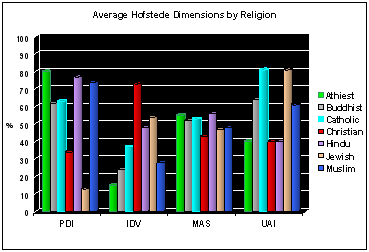
What
we see in this study is not surprising - there is a high
level of correlation between a country’s predominant
religion and one of the Hofstede Dimensions. This correlation
is validated in non-associated countries around the world,
i.e. comparing Catholic countries in Latin America to Catholic
countries in Europe.
Therefore, for those individuals who work in international
business, it is paramount to clearly understand and accept
the deeply ingrained ideas, beliefs, and attitudes of each
country and culture. For these are not based just on culture
alone, but also on religion. And, religion is a belief system
that cannot be challenged or changed with any form of logic,
education, or training.
IF conflicts and disagreements are analyzed from the perspective
of a combination of their cultural and religious foundations,
the disagreements frequently become more understandable.
It also becomes clear that resolution will be extremely difficult,
whether on a world scale, or a business-negotiating table.
Send
us your feedback@ibc-mail.com
Global
Resource Spotlight?
Each
month we Spotlight a free resource for readers that focuses
on Global business. This month's Spotlight is on Optimize
Magazine online. Specializing in strategy and execution
for business technology executives, they have a global
issues segment, as well as good information articles
on business like Outside-the-Box
Manufacturing.
International
Success Tips by Kimberley Roberts
 Doing
business around the world has been streamlined with telephone
calls, e-mails and video conferences. But the importance
of a personal meeting with associates and clients will
never be replaced by modern technology. At times the meeting
will be between, or among, trusted colleagues who have
done business together for years. At other times, a first
meeting will be taking place with the hope of establishing
a beneficial and rewarding relationship. Doing
business around the world has been streamlined with telephone
calls, e-mails and video conferences. But the importance
of a personal meeting with associates and clients will
never be replaced by modern technology. At times the meeting
will be between, or among, trusted colleagues who have
done business together for years. At other times, a first
meeting will be taking place with the hope of establishing
a beneficial and rewarding relationship.
When
a meeting is scheduled with people from other cultures,
it’s wise to be cognizant of that culture’s
protocol. To establish a professional tone for the meeting
and make a good first impression, become familiar with
the standard greeting for the country, or the cultural
group within the country, you will be meeting.
The
handshake is used as a greeting throughout the world. In
western countries it’s the standard, and in other
countries it has replaced the more traditional greeting.
For countries that may use the handshake, in addition to
a traditional greeting, it is nice to know both. Then,
when greeting the other person, pause and wait for a clue
as to which greeting you should use.
Men
are safe in extending a hand to another man. However, the
rules may change when a man greets a woman; or a woman
greets a man, or even another woman. Following are several
tips that will simplify the greeting and give you some
helpful information.
-
Germany and the United States have firm handshakes, with
the German being very brief and the US being about three
to four seconds
- France, Guatemala, and Japan have more limp handshakes
- Singapore has a longer handshake (10+ seconds)
- Women should be the first to offer a hand for a handshake in New Zealand,
Singapore, South Korea, or Taiwan
-
In South Korea, more respect is shown by cupping your
left hand under your right forearm, as if supporting
your right forearm during the hand shake
- A traditional bow may be used in China,
Hong Kong, or Japan
- Traditional greeting in India is namaste
-place the hands in a praying position, palms
together with the fingers just beneath the
chin, bow and
say namaste
- Traditional greeting in Thailand places
the hands, palms together, in front of the
chin, bow the head to touch the top of the
fingers, and say Wai
- Women may greet other women by patting the right
forearm or shoulder in Chile, Costa Rica, El Salvador,
Honduras, Mexico, Nicaragua, or Panama
-
Countries with Hindu and Muslim religions forbid public contact between men
and women. When in these countries, follow your host’s cue to determine
if religious tradition will be followed.
- Women should wait for a man to offer his hand first in a Hindu or Muslim
country, if a western handshake is going to be used
As
you can see from this list, even people in countries that
have religious beliefs forbidding public contact between
men and women may use the handshake as a business greeting
when meeting a businessman or businesswoman.
To
be professional each time you meet with people from countries
or cultures that have these strong religious beliefs, don’t
assume the handshake will be the appropriate greeting.
Anticipate the situation and what greeting options may
be needed. Then in a relaxed and confident manner, follow
the clue from the meeting’s host.
Send
us your feedback@ibc-mail.com
If
you've enjoyed this newsletter, please forward it to a friend! Subscribe
Today!
About
the International Business Center newsletter
The IBC Newsletter is sent monthly
to international executives, managers, supervisors, and
international business
school students. The Newsletter focuses on issues, information,
and trends of importance to conducting business on a Global
perspective.
This
Newsletter is sent only to those who request it. If you
have received this Newsletter and do not believe you requested
it, please use this link to stop
delivery.
For
more information and resources for Global Business visit
our website at: International Business Center
|
